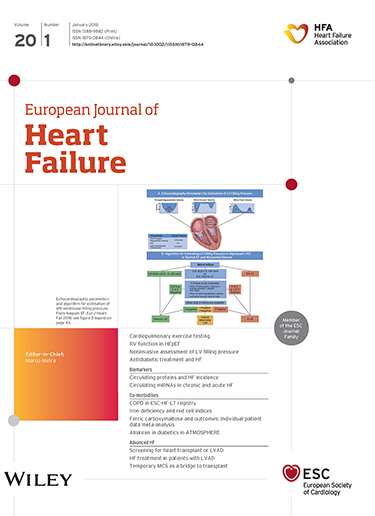磷酸蛋白p.Arg14del心肌病的年龄相关外显率。
IF 16.9
1区 医学
Q1 CARDIAC & CARDIOVASCULAR SYSTEMS
引用次数: 0
摘要
先前的研究表明,携带致病性p.a g14del变异的磷蛋白(PLN)携带者有更高的死亡率、心力衰竭和恶性室性心律失常的风险。然而,关于这些突变携带者的心脏特征外显率的数据很少,临床随访的最佳起始年龄和间隔时间仍有待确定。方法与结果我们收集了PLN p (Arg14del)携带者的临床资料。心脏外显率定义为主要事件或危险因素的存在。主要事件包括恶性室性心律失常或症状性心力衰竭。危险因素为低电压心电图、复极异常、频繁出现过早复合体、左室射血分数<45%或磁共振成像显示心脏纤维化。使用Kaplan-Meier分析(有或没有左截断)来评估外显率。我们确定了868例p.(Arg14del)携带者,首次心脏评估时的中位年龄为43岁(四分位间距[IQR] 29-55岁)。中位随访5.3 (IQR 2.2-8.5)年,207例(23.8%)携带者发生重大事件,平均年龄51(±15)岁。外显率与年龄相关,从青春期到老年出现新的心脏表型。在70岁时,主要事件的外显率为43%至70%,风险因素的外显率为84%至100%,这取决于使用哪种Kaplan-Meier方法。结论:PLN p (Arg14del)携带者主要心脏事件的外显率很高,在70岁时外显率高达70%。一种心脏危险因素的外显率在年龄较大时几乎完全。此外,心脏表型可以从青春期到老年出现。终生心脏随访是必要的,从青春期开始。本文章由计算机程序翻译,如有差异,请以英文原文为准。
Age-related penetrance of phospholamban p.Arg14del cardiomyopathy.
AIMS
Previous studies have shown that carriers of the pathogenic p.Arg14del variant in phospholamban (PLN) have an increased risk of mortality, heart failure and malignant ventricular arrhythmias. However, there are sparse data on the penetrance of cardiac features in these mutation carriers, and the optimal starting age and intervals of clinical follow-up remain to be defined.
METHODS AND RESULTS
We collected clinical data from PLN p.(Arg14del) carriers. Cardiac penetrance was defined as the presence of a major event or risk factor. A major event consisted of malignant ventricular arrhythmias or symptomatic heart failure. Risk factors were low-voltage electrocardiogram, repolarization abnormalities, frequent premature complexes, left ventricular ejection fraction <45% or cardiac fibrosis on magnetic resonance imaging. Kaplan-Meier analysis with and without left truncation was used to assess penetrance. We identified 868 p.(Arg14del) carriers, with a median age of 43 (interquartile range [IQR] 29-55) years at first cardiac evaluation. Median follow-up was 5.3 (IQR 2.2-8.5) years and 207 (23.8%) carriers had a major event, at a mean age of 51 (± 15) years. Penetrance was age-related, with new cardiac phenotypes emerging from adolescence to senior age. At age 70, penetrance of a major event was 43% to 70%, penetrance of a risk factor was 84% to 100% depending on which Kaplan-Meier method was used.
CONCLUSION
Penetrance of a major cardiac event is high in PLN p.(Arg14del) carriers, with a penetrance up to 70% at age 70. Penetrance of a cardiac risk factor is nearly complete at older age. Furthermore, cardiac phenotypes can emerge from adolescence to senior age. Life-long cardiac follow-up is needed, starting from adolescence.
求助全文
通过发布文献求助,成功后即可免费获取论文全文。
去求助
来源期刊

European Journal of Heart Failure
医学-心血管系统
CiteScore
27.30
自引率
11.50%
发文量
365
审稿时长
1 months
期刊介绍:
European Journal of Heart Failure is an international journal dedicated to advancing knowledge in the field of heart failure management. The journal publishes reviews and editorials aimed at improving understanding, prevention, investigation, and treatment of heart failure. It covers various disciplines such as molecular and cellular biology, pathology, physiology, electrophysiology, pharmacology, clinical sciences, social sciences, and population sciences. The journal welcomes submissions of manuscripts on basic, clinical, and population sciences, as well as original contributions on nursing, care of the elderly, primary care, health economics, and other related specialist fields. It is published monthly and has a readership that includes cardiologists, emergency room physicians, intensivists, internists, general physicians, cardiac nurses, diabetologists, epidemiologists, basic scientists focusing on cardiovascular research, and those working in rehabilitation. The journal is abstracted and indexed in various databases such as Academic Search, Embase, MEDLINE/PubMed, and Science Citation Index.
 求助内容:
求助内容: 应助结果提醒方式:
应助结果提醒方式:


